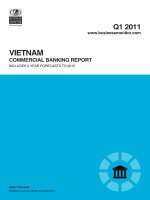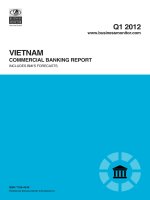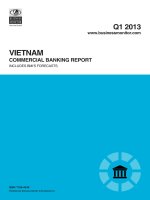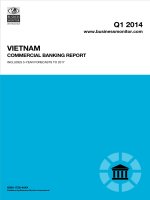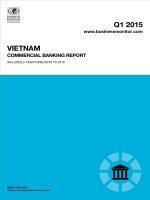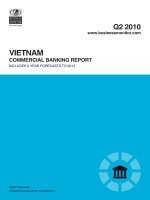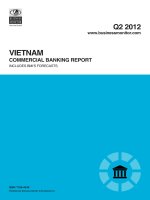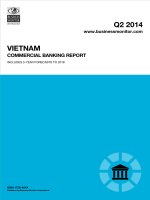Vietnam commercial banking report q1 2011
Bạn đang xem bản rút gọn của tài liệu. Xem và tải ngay bản đầy đủ của tài liệu tại đây (470.65 KB, 59 trang )
Q1 2011
www.businessmonitor.com
COMMERCIAL BANKING REPORT
ISSN 1758-454X
Published by Business Monitor International Ltd.
VIETNAM
INCLUDES 5-YEAR FORECASTS TO 2015
Business Monitor International
Mermaid House,
2 Puddle Dock,
London, EC4V 3DS,
UK
Tel: +44 (0) 20 7248 0468
Fax: +44 (0) 20 7248 0467
Email:
Web:
© 2011 Business Monitor International.
All rights reserved.
All information contained in this publication is
copyrighted in the name of Business Monitor
International, and as such no part of this publication
may be reproduced, repackaged, redistributed, resold in
whole or in any part, or used in any form or by any
means graphic, electronic or mechanical, including
photocopying, recording, taping, or by information
storage or retrieval, or by any other means, without the
express written consent of the publisher.
DISCLAIMER
All information contained in this publication has been researched and compiled from sources believed to be accurate and reliable at the time of
publishing. However, in view of the natural scope for human and/or mechanical error, either at source or during production, Business Monitor
International accepts no liability whatsoever for any loss or damage resulting from errors, inaccuracies or omissions affecting any part of the
publication. All information is provided without warranty, and Business Monitor International makes no representation of warranty of any kind as
to the accuracy or completeness of any information hereto contained.
VIETNAM COMMERCIAL
BANKING REPORT Q1 2011
INCLUDING 5-YEAR INDUSTRY FORECASTS TO 2015
Part of BMI’s Industry Report & Forecasts Series
Published by: Business Monitor International
Copy deadline: January 2011
Vietnam Commercial Banking Report Q1 2011
© Business Monitor International Ltd Page 2
Vietnam Commercial Banking Report Q1 2011
© Business Monitor International Ltd Page 3
CONTENTS
Executive Summary 5
Table: Levels (VNDbn) 5
Table: Levels (US$bn) 5
Table: Levels At August 2009 5
Table: Annual Growth Rate Projections 2010-2014 (%) 5
Table: Ranking Out Of 59 Countries Reviewed In 2010 6
Table: Projected Levels (VNDbn) 6
Table: Projected Levels (US$bn) 6
SWOT Analysis 7
Vietnam Commercial Banking SWOT 7
Vietnam Political SWOT 7
Vietnam Economic SWOT 8
Vietnam Business Environment SWOT 8
Business Environment Outlook 9
Commercial Banking Business Environment Ratings 9
Table: Vietnam’s Commercial Banking Business Environment Rating 9
Commercial Banking Business Environment Rating Methodology 9
Table: Asia Commercial Banking Business Environment Ratings 10
Global Commercial Banking Outlook 12
Asia Banking Sector Outlook 18
Table: Banks' Bond Portfolios 20
Table: Asia Commercial Banking Business Environment Ratings 21
Table: Comparison Of Loan/Deposit, Loan/Asset And Loan/GDP Ratios 22
Table: Anticipated Developments In 2011 23
Table: Comparison Of Total Assets, Client Loans And Client Deposits, 2009-2010 (US$bn) 24
Table: Comparison Of Per Capita Deposits, 2010e (US$) 25
Table: Interbank Rates And Bond Yields, 2009-2010 26
Vietnam Banking Sector Outlook 27
Economic Outlook 30
Table: Vietnam Economic Activity, 2007-2015 31
Company Profiles 33
Vietcombank 33
Table: Key Statistics For Vietcombank, 2004-2008 (VNDmn) 34
BIDV 35
Table: Key Statistics For BIDV, 2004-2006 (VNDmn) 36
VietinBank 37
Table: Key Statistics For VietinBank, 2005-2008 (VNDmn) 38
Agribank 39
Table: Balance Sheet (VNDmn, unless stated) 40
Table: Balance Sheet (US$mn, unless stated) 40
Table: Key Ratios (%) 40
MHB Bank 41
Vietnam Commercial Banking Report Q1 2011
© Business Monitor International Ltd Page 4
Table: Key Statistics For MHB Bank, 2006-2008 (VNDmn) 42
Habubank 43
Table: Key Statistics For Habubank, 2004-2007 (VNDmn) 44
Eximbank 45
Table: Balance Sheet (VNDmn, unless stated) 46
Table: Balance Sheet (US$mn, unless stated) 46
Table: Key Ratios (%) 46
Sacombank 47
Table: Stock Market Indicators 48
Table: Balance Sheet (VNDmn, unless stated) 48
Table: Balance Sheet (US$mn, unless stated) 49
Table: Key Ratios (%) 49
Saigonbank 50
Table: Stock Market Indicators 50
Table: Balance Sheet (VNDmn, unless stated) 51
Table: Balance Sheet (US$mn, unless stated) 51
Table: Key Ratios (%) 51
SeABank 52
Table: Balance Sheet (VNDmn, unless stated) 53
Table: Balance Sheet (US$mn, unless stated) 53
Table: Key Ratios (%) 53
BMI Banking Sector Methodology 54
Commercial Bank Business Environment Rating 55
Table: Commercial Banking Business Environment Indicators And Rationale 56
Table: Weighting Of Indicators 57
Vietnam Commercial Banking Report Q1 2011
© Business Monitor International Ltd Page 5
Executive Summary
Table: Levels (VNDbn)
Date
Total
Assets
Client
Loans
Bond
Portfolio
Other
Liabilities&
Capital
Capital
Client
Deposits
Other
August 2008 1,659,548.7
1,259,980.0
149,816.7
249,752.0
1,659,548.7
217,173.0
1,205,967.7
236,408.0
August 2009 2,065,761.6
1,706,340.0
173,358.3
186,063.3
2,065,761.6
286,547.0
1,594,992.6
184,222.0
Change, % 24%
35%
16%
-26%
24%
32%
32%
-22%
Source: BMI, SBV
Table: Levels (US$bn)
Date
Total
Assets
Client
Loans
Bond
Portfolio
Other
Liabilities
& Capital
Capital
Client
Deposits
Other
August 2008 100.4
76.2
9.1
15.1
100.4
13.1
73.0
14.3
August 2009 116.0
95.8
9.7331
10.4
116.0
16.1
89.6
10.3
Change, % 15%
26%
7%
-31%
15%
22%
23%
-28%
Source: BMI, SBV
Table: Levels At August 2009
Loan/Deposit Ratio Loan/Asset Ratio
Loan/GDP Ratio
GDP Per Capita,
US$
Deposits Per
Capita, US$
106.98% 82.60% 107.32% 1,058 1,030
Rising Falling Rising
Source: BMI, SBV
Table: Annual Growth Rate Projections 2010-2014 (%)
Assets
Loans
Deposits
Annual Growth Rate 24
24
14
CAGR 25
25
13
Ranking 1
1
15
Source: BMI, SBV
Vietnam Commercial Banking Report Q1 2011
© Business Monitor International Ltd Page 6
Table: Ranking Out Of 59 Countries Reviewed In 2010
Loan/Deposit Ratio Loan/Asset Ratio
Loan/GDP Ratio
7 2
10
Local Currency Asset Growth Local Currency Loan Growth
Local Currency Deposit Growth
1 1
14
Source: BMI, SBV
Table: Projected Levels (VNDbn)
2007
2008
2009e 2010f 2011f 2012f 2013f 2014f 2015f
Total
Assets
1410221.40 1747335.40 2411322.85 2893587.42 3472304.91 4236211.99 5252902.86 6566128.58 8273322.01
Client
Loans
1067730.00 1339260.00 1848178.80 2217814.56 2661377.47 3246880.52 4026131.84 5032664.80 6341157.65
Client
Deposits
1100392.90 1341142.80 1528902.79 1697082.10 1917702.77 2186181.16 2492246.52 2841161.04 3267335.19
e/f = BMI estimate/forecast. Source: BMI, SBV
Table: Projected Levels (US$bn)
2007
2008
2009e 2010f 2011f 2012f 2013f 2014f 2015f
Total Assets 88.04
99.96
130.56
148.39
173.62
211.81
269.38
345.59
447.21
Client Loans 66.66
76.62
100.07
113.73
133.07
162.34
206.47
264.88
342.77
Client Deposits 68.70
76.72
82.78
87.03
95.89
109.31
127.81
149.53
176.61
e/f = BMI estimate/forecast. Source: BMI, SBV
Vietnam Commercial Banking Report Q1 2011
© Business Monitor International Ltd Page 7
SWOT Analysis
Vietnam Commercial Banking SWOT
Strengths
Rapid growth.
Untapped potential.
The high savings rate of Vietnamese households.
Increasingly open to foreign banks since accession to the WTO in 2007.
The role of state-owned banks is steadily decreasing.
Weaknesses
Domestic banks lack the capital and technology to sustain high credit growth.
The financial accounts of many banks are still opaque.
High exposure to real estate and stock market loans among smaller banks.
Opportunities
The population is still under-banked.
Income levels are likely to rise strongly over the medium term.
Threats
The National Congress of the Communist Party of Vietnam in January 2011 could
result in a shift of economic policy away from further liberalisation.
Vietnam Political SWOT
Strengths
The Communist Party government appears committed to market-oriented reforms,
although specific economic policies will undoubtedly be discussed at the 2011
National Congress. The one-party system is generally conducive to short-term
political stability.
Relations with the US are generally improving, and Washington sees Hanoi as a
potential geopolitical ally in South East Asia.
Weaknesses
Corruption among government officials poses a major threat to the legitimacy of the
ruling Communist Party.
There is increasing (albeit still limited) public dissatisfaction with the leadership’s
tight control over political dissent.
Opportunities
The government recognises the threat that corruption poses to its legitimacy, and
has acted to clamp down on graft among party officials.
Vietnam has allowed legislators to become more vocal in criticising government
policies. This is opening up opportunities for more checks and balances within the
one-party system.
Threats
The slowdown in growth in 2009 and 2010 is likely to weigh on public acceptance of
the one-party system, and street demonstrations to protest economic conditions
could develop into a full-on challenge of undemocratic rule.
Although strong domestic control will ensure little change to Vietnam’s political
scene in the next few years, over the longer term, the one-party-state will probably
be unsustainable.
Relations with China have deteriorated in recent years due to Beijing’s more
assertive stance over disputed islands in the South China Sea and domestic
criticism of a large Chinese investment into a bauxite mining project in the central
highlands, which could potentially cause widespread environmental damage.
Vietnam Commercial Banking Report Q1 2011
© Business Monitor International Ltd Page 8
Vietnam Economic SWOT
Strengths
Vietnam has been one of the fastest growing economies in Asia in recent years,
with GDP growth averaging 7.6% annually between 2000 and 2007.
The economic boom has lifted many Vietnamese out of poverty, with the official
poverty rate in the country falling from 58% in 1993 to 20% in 2004.
Weaknesses
Vietnam still suffers from substantial trade, current account and fiscal deficits,
leaving the economy vulnerable as the global economy continued to suffer in 2010.
The fiscal picture is clouded by considerable ‘off the books’ spending.
The heavily-managed and weak dong currency reduces incentives to improve
quality of exports, and also serves to keep import costs high, thus contributing to
inflationary pressures.
Opportunities
WTO membership has given Vietnam access to both foreign markets and capital,
while making Vietnamese enterprises stronger through increased competition.
The government will, despite the current macroeconomic woes, continue to move
forward with market reforms, including privatisation of state-owned enterprises, and
liberalising the banking sector.
Urbanisation will continue to be a long-term growth driver. The UN forecasts the
urban population to rise from 29% of the population to more than 50% by the early
2040s.
Threats
Inflation and deficit concerns have caused some investors to re-assess their hitherto
upbeat view of Vietnam. If the government focuses too much on stimulating growth
and fails to root out inflationary pressure, it risks prolonging macroeconomic
instability, which could lead to a potential crisis.
Prolonged macroeconomic instability could prompt the authorities to put reforms on
hold, as they struggle to stabilise the economy.
Vietnam Business Environment SWOT
Strengths
Vietnam has a large, skilled and low-cost workforce which has made the country
attractive to foreign investors.
Vietnam’s proximity to China and South East Asia, and its good sea links, make it a good
base for foreign companies to export to the rest of Asia, and beyond.
Weaknesses
Vietnam’s infrastructure is still weak. Roads, railways and ports are inadequate to cope
with the country’s economic growth and links with the outside world.
Vietnam remains one of the world’s most corrupt countries. Its score in Transparency
International’s 2010 Corruption Perceptions Index was 2.7, placing it in 22
nd
place in the
Asia Pacific region and 116
th
overall.
Opportunities
Vietnam is increasingly attracting investment from key Asian economies, such as Japan,
South Korea and Taiwan. This offers the possibility of the transfer of high-tech skills and
knowhow.
Vietnam is pressing ahead with the privatisation of state-owned enterprises and the
liberalisation of the banking sector. This should offer foreign investors new entry points.
Threats
Ongoing trade disputes with the US, and the general threat of American protectionism,
which will remain a concern.
Labour unrest remains a lingering threat. Failure by the authorities to boost skills levels
could leave Vietnam a second-rate economy for an indefinite period.
Vietnam Commercial Banking Report Q1 2011
© Business Monitor International Ltd Page 9
Business Environment Outlook
Commercial Banking Business Environment Ratings
Table: Vietnam’s Commercial Banking Business Environment Rating
Limits of Potential Returns
Data
Score, out of 10
Ratings score, out of 100
Total assets, 2010 US$130.6mn
6
Market Structure 63
Growth in total assets, 2010-2015
6
Growth in client loans, 2010-2015
7
GDP per capita, 2010 US$1,085.0
2
Country Structure 53
Tax 2.9
3
GDP volatility 0.6
10
Financial infrastructure 5.6
6
Risks to Realisation of Returns
Regulatory framework and development 4.5
5
Market Risk 40
Regulatory framework and competitive landscape 5.0
5
Moody’s rating for local currency deposits 2.0
2
Long-term financial risk 4.8
5
Country Risk 46
Long-term external risk 3.3
3
Long-term policy continuity 7.0
7
Legal framework 3.7
4
Bureaucracy 3.9
4
Commercial banking business environment rating
54
Source: BMI
Commercial Banking Business Environment Rating Methodology
Since Q108, we have described numerically the banking business environment for each of the countries
surveyed by BMI. We do this through our Commercial Banking Business Environment Rating (CBBER),
a measure that ensures we capture the latest quantitative information available. It also ensures consistency
across all countries and between the inputs to the CBBER and the Insurance Business Environment
Rating, which is likewise now a feature of our insurance reports. Like the Business Environment Ratings
calculated by BMI for all the other industries on which it reports, the CBBER takes into account the
limits of potential returns and the risks to the realisation of those returns. It is weighted 70% to the former
and 30% to the latter.
Vietnam Commercial Banking Report Q1 2011
© Business Monitor International Ltd Page 10
The evaluation of the Limits of Potential Returns includes market elements that are specific to the
banking industry of the country in question and elements that relate to that country in general. Within the
70% of the CBBER that takes into account the ‘Limits of potential returns’, the market elements have a
60% weighting and the country elements have a 40% weighting. The evaluation of the Risks to
Realisation of Returns also includes banking elements and country elements (specifically, BMI’s
assessment of long-term country risk). However, within the 30% of the CBBER that take into account the
risks, these elements are weighted 40% and 60%, respectively.
Further details on how we calculate the CBBER are provided at the end of this report. In general, though,
three aspects need to be borne in mind in interpreting the CBBERs. The first is that the market elements
of the Limits of Potential Returns are by far the most heavily weighted of the four elements. They account
for 60% of 70% (or 42%) of the overall CBBER. Second, if the market elements are significantly higher
than the country elements of the Limits of Potential Returns, it usually implies that the banking sector is
(very) large and/or developed relative to the general wealth, stability and financial infrastructure in the
country. Conversely, if the market elements are significantly lower than the country elements, it usually
means that the banking sector is small and/or underdeveloped relative to the general wealth, stability and
financial infrastructure in the country. Third, within the Risks to Realisation of Returns category, the
market elements (ie: how regulations affect the development of the sector, how regulations affect
competition within it, and Moody’s Investors Service’s ratings for local currency deposits) can be
markedly different from BMI’s long-term risk rating.
Table: Asia Commercial Banking Business Environment Ratings
Limits of Potential
Returns
Risks to Potential
Returns Overall
Market
Structure
Country
Structure
Market
Risks
Country
Risks
Rating
Ranking
Bangladesh 43.3
45.0
30.0
42.0
42.0
52
China 93.3
55.0
56.7
76.0
75.1
13
Hong Kong 73.3
90.0
70.0
84.0
79.5
9
India 83.3
55.0
53.3
56.0
66.9
24
Indonesia 73.3
62.5
76.7
42.0
65.1
29
Japan 30.0
75.0
63.3
80.0
55.6
38
Malaysia 70.0
80.0
76.7
80.0
75.4
12
Pakistan 33.3
47.5
56.7
40.0
41.3
55
Philippines 50.0
60.0
56.7
50.0
53.6
43
Singapore 66.7
90.0
96.7
88.0
80.6
7
Vietnam Commercial Banking Report Q1 2011
© Business Monitor International Ltd Page 11
Table: Asia Commercial Banking Business Environment Ratings
Limits of Potential
Returns
Risks to Potential
Returns Overall
Market
Structure
Country
Structure
Market
Risks
Country
Risks
Rating
Ranking
Sri Lanka 20.0
55.0
36.7
44.0
36.1
56
South Korea 76.7
85.0
76.7
68.0
77.4
10
Taiwan 70.0
70.0
83.3
74.0
72.3
17
Thailand 56.7
65.0
80.0
68.0
63.8
31
Vietnam 63.3
52.5
40.0
46.0
54.4
41
US 90.0
85.0
100.0
78.0
87.6
2
Scores out of 100, with 100 the highest. Source: BMI
Vietnam Commercial Banking Report Q1 2011
© Business Monitor International Ltd Page 12
Global Commercial Banking Outlook
Emerging Markets Still Set To Outperform
Our outlook for commercial banking in emerging markets remains broadly positive, with more robust
economic growth and healthier banking systems than in most of their developed world counterparts. We
emphasise that the key macroeconomic dynamics underpinning global banking in 2011 will continue to
be deflation and deleveraging in much of the developed world, contrasting with inflation and lending
growth in emerging markets. The implementation of quantitative easing policies by major central banks,
notably the US Federal Reserve and the Bank of Japan, will result in the purchase of hundreds of billions
of dollars worth of government securities in an effort to grease the wheels of lending. While we are not
convinced that quantitative easing will have significant positive effects for economic growth, or even for
lending, increasing central bank support will further reduce the potential for another systemic banking
crisis, which fits with our core assumptions. However, it could fuel asset price inflation and tighter policy
in emerging markets, which could eventually lead to a boom-and-bust cycle. Meanwhile, the introduction
of a new Basel framework on banking regulation will also underpin confidence in banking stability, and
does not greatly threaten lending growth, given banks’ pre-emptive capital raising and the gradual
schedule for Basel III implementation.
Regional Outlooks: Uneven Recovery Underway
Below we present brief outlooks for regional banking sectors:
Developed states: We continue to expect underperformance by the developed world’s banking sectors in
terms of loan growth and profitability compared with emerging markets. This is due to our below-
consensus outlook for economic growth in developed states, the likelihood of retrenchment by both
households and governments, and the potential for tighter sector regulation. In the US, loan growth will
remain slow due to ongoing post-recession household deleveraging. A major concern for the eurozone
heading into 2011 is the impact that government austerity measures will have on demand. Should
governments cut too far at a time when consumer spending and investment is yet to sufficiently recover,
growth could quickly stagnate. This would further dent the operating outlook for European banks and
could mean more deterioration in asset quality as non-performing loans edge higher.
Vietnam Commercial Banking Report Q1 2011
© Business Monitor International Ltd Page 13
Weak Outlook
Europe – Banking Sector Asset Growth, % y-o-y
Source: BMI, central banks
Emerging Asia: After suffering only minor profit damage from the global financial crisis due to their
strong capitalisation and less risky lending practices than in the US and Europe, Asian banks are now
increasingly positioning for growth. The well capitalised nature of the region’s banking sector is the main
reason why banks are now in a position to expand their loan books and support domestic economic
growth, and with the exception of Japan we continue to forecast solid equity-to-asset ratios preventing
any major banking sector dislocation, even if property bubbles across the region continue to inflate and
burst in 2011. Despite the limited crisis risks we remain concerned that profitability will take a significant
hit once hot money inflows into Asia slow down.
Latin America: Thanks to prudential regulation and a lack of cross-border lending few banking sectors
in Latin America face systemic risks, even with the wave of foreign capital entering the region. We
believe that over the long-term time, Peru offers the greatest potential in the region for commercial
banking sector expansion, followed by Mexico and Guatemala.
Vietnam Commercial Banking Report Q1 2011
© Business Monitor International Ltd Page 14
Searching For Potential
Latin America – Commercial Banking Sector Assets-to-GDP, %
Source: BMI, central banks, national financial regulators
Emerging Europe: Our outlook for the emerging Europe banking sector is mixed, reflecting the
divergent growth trajectories that we forecast for the region. We have long highlighted Turkey and
Poland as economic outperformers in the region, with domestic demand driving rapid economic
convergence with Western peers. We highlight Hungary and Romania as two countries where the outlook
for the banking industry is negatively affected by domestic economic conditions.
Middle East and North Africa: That a significant share of lending throughout MENA was directed
towards the real estate and construction sectors, particularly in Bahrain and Kuwait, in the run-up to 2009
underscores our view that a return to pre-crisis asset and loan growth rates will be unlikely for the
foreseeable future. While the outlook for lending to the real estate sector appears relatively weak, except
in Saudi Arabia, we expect the infrastructure sector to play an increasingly important role in driving loan
growth, particularly given the number large-scale projects in the pipeline. While a robust bounce in asset
growth and profitability should not be expected in the short term, a recovery (within the Gulf Cooperation
Council in particular) should begin to gain steam in H111 concomitant with publicly funded investment
projects.
Sub-Saharan Africa: Sub-Saharan Africa’s major banking sectors (South Africa, Nigeria, Ghana and
Kenya) all survived the global financial crisis and are continuing to rebound from the various difficulties
they experienced in 2009. Rebounding economic activity and improved liquidity are bolstering growth,
Vietnam Commercial Banking Report Q1 2011
© Business Monitor International Ltd Page 15
and the most recent available data for the region show that the recovery in the banking sector is
accelerating.
South Africa Lagging
Africa – Banking Sector Asset Growth, % y-o-y
Source: South African Reserve Bank; Central Bank of Nigeria; Central Bank of Kenya
Basel III: Still Some Uncertainty
The Basel Committee on Banking Supervision signed off its new capital requirements in September 2010,
marking a regulatory regime shift from Basel II to Basel III. Overall, we believe that Basel III will make
the global banking system more robust. However, some questions remain about the implementation and
enforcement of the new regulations. The key revisions were:
The quality and size of capital ratios are to be strengthened. These will include a common equity
(core) capital requirement of 4.5% of risk-adjusted assets plus a ‘conservation buffer’ of 2.5%
for a total requirement of 7.0% (compared with the 2.0% minimum under Basel II). Failure to
meet the conservation buffer will lead to constraints on dividend payments and bonuses. The
broader Tier 1 ratio requirement is being raised from 4.0% to 6.0% (8.5% including the
conservation buffer).
Tier 1 equity capital is going to be redefined to exclude lower-quality assets, including deferred
tax assets, while asset weightings will be less forgiving. All of this will toughen ratio
requirements, meaning that some banks that meet current criteria will have to improve their
capital levels to meet Basel III standards.
Vietnam Commercial Banking Report Q1 2011
© Business Monitor International Ltd Page 16
The less quantifiable amendments include the creation of a ‘macroprudential overlay’. This
includes mandating that banks build up buffers of a 0-2.5% of risk-adjusted assets in the upward
part of the economic cycle that can be drawn upon in slowdowns. Furthermore, the Basel
Committee are exploring measures to deal with the systemic risks caused by banks that are ‘too
big to fail’, which may include larger capital requirements and surcharges for big banks.
Raising The Bar
Capital Requirements As % Of Risk-Weighted Assets
Source: Bank for International Settlements
Basel III is not going to make a major difference to BMI’s short-term forecasts. For a start, the revisions
are certainly more stringent but not as tough as they could have been, and banks (and markets) were
slightly relieved at the announcement. Banks also have until 2019 to comply with the new regulations,
meaning that implementation will be gradual and have a more limited effect on the short-term outlook. In
addition, banks are generally already ahead of the game on capital raising. The new requirements will not
require major levels of new equity issuance on aggregate, with most major banks easily meeting the broad
Tier 1 criteria set out by Basel III. These are minimum standards and in the post-Lehman environment
investors have looked for banks to build stronger capital bases anyway.
There are, however, unanswered questions about the new regulatory requirements that cloud the medium-
term outlook. The biggest questions for us is how the countercyclical measures will work and what
further steps might be taken to rein in risks from ‘too big to fail’ banks. As it stands, domestic authorities
will have to decide whether the rate of economic activity exceeds the desirable, pre-set pace of growth for
any particular country. We believe that since the criteria will boil down to country-specific regulations it
will be difficult to reach consensus on this issue. Regulations that are too stringent for a specific country,
particularly if the economic trajectory is not as expected, would force further capital raising or profit
retention and could well lead to lower loan growth. It would certainly complicate the work of fiscal and
monetary policymakers in participating countries as it would add another layer of countercyclicality to the
economy, in addition to tighter or looser official policy.
Vietnam Commercial Banking Report Q1 2011
© Business Monitor International Ltd Page 17
Other questions relate to the composition of capital. For example, the requirement for banks to hold
sufficient cash and government paper to meet a liquidity coverage ratio and survive a 30-day market crisis
may be difficult to meet for emerging market banks operating in countries without deep, liquid
government bond markets. As such, the Basel Committee agreed that this requirement would be
‘observational’ until 2015, but other questions remain. Even if these liquidity requirements are met, we
question whether the perceived risk of government paper is line with the actual risk: what of sovereign
bonds in ‘safe’ countries that are, in BMI’s view, at risk of restructuring or defaulting, including some in
the eurozone such as Greece and Portugal?
Ultimately, Basel III’s success will be determined by whether it improves the stability of the banking
sector while not stifling innovation, profitability and lending. We believe it is an improvement on the
previous framework but several questions still need to be answered.
Vietnam Commercial Banking Report Q1 2011
© Business Monitor International Ltd Page 18
Asia Banking Sector Outlook
Banks Riding The Liquidity Wave
With the developed world’s central banks accelerating their monetary stimulus measures, the potential for
a continued surge in hot money inflows into Asia is high. This poses major risks for local banking sectors,
not only due to the formation of asset bubbles, but also in lending to the real economy as banks increase
credit expansion across the region. There could be a spike in non-performing loans (NPLs) if easy
monetary policy is forcefully reversed down the line, although the crisis risks are minimal.
Governments and central banks in Asia have kept their currencies artificially weak in recent years. This
has attracted a surge in speculative inflows as investors believe these currencies will eventually have to be
revalued. Because of the large current account surpluses across the region, most countries are exporting
capital and capital controls are unlikely to stop the flood of money coming in. While South Korea sets
limits on banks’ exposure to foreign exchange derivatives, Indonesia has introduced measures such as a
one-month minimum holding period on monetary instruments issued by the central bank and Thailand
removed the tax exemption of foreign purchases of government bonds, such measures are unlikely to
stem the tide. The solution would be for Asian central banks to allow their currencies to revalue to the
extent that this would eliminate their current account surpluses, but we believe this is unlikely and even if
it were to happen it could attract more destabilising inflows in the interim. Whatever path is chosen, it
seems that Asian banks would be forced to absorb an increasing amount of liquidity. While this should
help profit growth and keep economic activity buoyant, the risk of a rise in NPLs in future is growing.
Hot Money Pouring In
Asia – Reserves At Asian Central Banks, US$bn
Source: BMI, central bank data
Vietnam Commercial Banking Report Q1 2011
© Business Monitor International Ltd Page 19
Crisis Passes, Positioning For Growth
After suffering only minor profit damage as a result of the global financial crisis due to strong
capitalisation and less risky lending practices than in the US and Europe, Asia’s banks are now
increasingly positioning for growth. Hong Kong has been the most clear example, where unfettered
currency inflows have allowed banks to increase lending, with credit growth coming in at 24.1% year-on-
year (y-o-y) in August 2010, after being in deeply negative territory 12 months earlier. As it has the
region’s most tightly managed peg and one of the highest current account surpluses this stands to reason.
We continue to caution, however, that burgeoning property prices could take a dip in 2011, undermining
loan quality for a large chunk of the banking sector.
While Hong Kong is perhaps the clearest example, we are seeing a shift in tact across the board. In
Singapore and Taiwan, also economies with huge fundamental upside pressure on their currencies, loan
growth has risen substantially. After dropping into negative territory in late 2009, Singaporean loan
growth has surged to almost 10% y-o-y in August 2010, and this is on top of continued overseas
expansion. The Taiwanese banking sector’s loan trajectory has shown a similar trend, supported by the
recent improvement in relations with Beijing. Meanwhile, Thailand’s loan-to-deposit ratio has ticked up
amid a newfound appetite for domestic lending, while Malaysian banks have accelerated lending with
support from widening interest margins and are increasingly expanding operations overseas.
Bubble Risks Grow
It is no surprise that the economies that are most actively seeking to prevent currency appreciation (Hong
Kong, China, Taiwan and Singapore) are experiencing the most significant upside pressure on local
property prices as hot money inflows are channelled into this area. Central bank sterilisation measures
have clearly been inadequate in preventing domestic currency weakness measures from feeding through
to local monetary expansion. As long as the US dollar continues to weaken, property bubbles across Asia
will continue to build, in our view.
Well Capitalised And Able To Withstand Potential Shocks
The well capitalised nature of the region’s banking sector was the main reason why banks are now in a
position to expand their loan books and support domestic economic growth, and with the exception of
Japan we continue to anticipate solid equity-to-asset ratios preventing any major banking sector
dislocation, even if property bubbles across Asia continue to inflate and burst in 2011. Tier 1 capital is
estimated to be above 10% across Asia, far in excess of the 6% figure agreed upon in the Basel III
requirements. Even in China, where we believe that the government may have to stand behind some of
the larger banks if the property bubble bursts and local governments threaten to default on loans, Tier 1
capital remains high compared to US and European banks, with Industrial and Commercial Bank of
China, one of the world’s largest bank by market value, boasting a common equity-to-assets ratio of
roughly 10%. Despite the limited crisis risks, we remain concerned that profitability will take a significant
hit once hot money inflows into Asia slow down.
Vietnam Commercial Banking Report Q1 2011
© Business Monitor International Ltd Page 20
Table: Banks' Bond Portfolios
Bond Portfolio, US$bn Bond, % total assets Year-on-Year growth, %
Bangladesh 15.7
26.0
19.4
China 1,358.8
11.5
24.9
Hong Kong 303.0
22.1
29.1
India 258.0
24.0
20.6
Indonesia 14.4
5.5
18.5
Japan 2,286.6
26.5
12.4
Malaysia 52.6
13.2
18.1
Pakistan 21.5
26.8
62.3
Philippines 31.9
27.0
16.8
Singapore 67.9
13.4
36.2
Sri Lanka 2.2
12.8
18.2
South Korea 225.7
15.6
-7.1
Taiwan 125.4
12.8
31.2
Thailand 50.7
16.3
22.4
Vietnam 10.3
10.3
6.7
US 2,500.5
19.1
22.8
Source: Central banks, regulators, BMI
Vietnam Commercial Banking Report Q1 2011
© Business Monitor International Ltd Page 21
Table: Asia Commercial Banking Business Environment Ratings
Limits of Potential
Returns
Risks to Potential
Returns
Overall
Market
Structure
Country
Structure
Market
Risks
Country
Risks
Rating
Ranking
Bangladesh 43.3
45.0
30.0
42.0
42.0
52
China 93.3
55.0
56.7
76.0
75.1
13
Hong Kong 73.3
90.0
70.0
84.0
79.5
8
India 83.3
55.0
53.3
56.0
66.9
24
Indonesia 73.3
62.5
76.7
42.0
65.1
29
Japan 30.0
75.0
63.3
80.0
55.6
37
Malaysia 70.0
80.0
76.7
80.0
75.4
12
Pakistan 33.3
47.5
56.7
40.0
41.3
55
Philippines 50.0
60.0
56.7
50.0
53.6
43
Singapore 66.7
90.0
96.7
88.0
80.6
6
Sri Lanka 20.0
55.0
36.7
44.0
36.1
56
South Korea 76.7
85.0
76.7
68.0
77.4
10
Taiwan 70.0
70.0
83.3
74.0
72.3
17
Thailand 56.7
65.0
80.0
68.0
63.8
31
Vietnam 63.3
52.5
40.0
46.0
54.4
41
US 90.0
85.0
100.0
78.0
87.6
2
Scores out of 100, with 100 the highest. Source: BMI
Vietnam Commercial Banking Report Q1 2011
© Business Monitor International Ltd Page 22
Table: Comparison Of Loan/Deposit, Loan/Asset And Loan/GDP Ratios
Loan/
Deposit
Ratio, % Rank Trend
Loan/
Asset
Ratio, % Rank Trend
Loan/
GDP
Ratio,
% Rank Trend
Bangladesh 76.7
41
Falling
64.7
13
Falling
43.7
43
Rising
China 69.5
49
Rising
52.6
38
Rising
127.4
9
Rising
Hong Kong 51.5
58
Falling
30.8
57
Rising
200.7
3
Rising
India 79.5
42
Falling
62.3
15
Rising
48.3
41
Rising
Indonesia 72.9
44
Falling
58.9
27
Falling
25.6
52
Falling
Japan 74.6
46
Falling
53.2
37
Falling
89.7
20
Rising
Malaysia 75.6
45
Falling
57.0
30
Rising
114.4
11
Rising
Pakistan 75.1
55
Falling
49.7
44
Falling
24.8
56
Falling
Philippines 66.5
53
Falling
50.1
40
Rising
35.8
48
Rising
Singapore 71.9
47
Falling
39.8
51
Falling
108.4
13
Rising
Sri Lanka 68.0
52
Falling
51.0
36
Falling
22.9
55
Falling
South Korea 122.7
12
Falling
70.6
7
Rising
110.1
12
Falling
Taiwan 75.1
43
Falling
59.8
24
Falling
154.7
7
Rising
Thailand 95.3
25
Falling
64.4
14
Falling
73.8
29
Falling
Vietnam 120.9
7
Rising
76.6
2
Falling
112.3
10
Rising
US 78.9
39
Falling
55.6
31
Falling
51.1
39
Falling
Source: Central banks, regulators, BMI
Vietnam Commercial Banking Report Q1 2011
© Business Monitor International Ltd Page 23
Table: Anticipated Developments In 2011
Loan/Deposit
Ratio, % Trend
Loan Growth,
US$bn
Deposit
Growth,
US$bn
Residual,
US$bn
Bangladesh 78.7
Rising
14.2
16.7
-2.5
China 69.5
Falling
1,172.0
1,685.3
-513.3
Hong Kong 55.7
Rising
43.4
16.6
26.9
India 77.5
Falling
185.6
261.1
-75.6
Indonesia 80.8
Rising
72.1
68.8
3.3
Japan 75.7
Rising
-556.5
-824.9
268.5
Malaysia 75.0
Falling
49.7
68.8
-19.1
Pakistan 72.7
Falling
4.5
7.7
-3.2
Philippines 64.7
Falling
12.2
21.4
-9.2
Singapore 74.2
Rising
34.9
38.2
-3.3
Sri Lanka 66.8
Falling
3.5
5.5
-2.0
South Korea 117.3
Falling
61.6
90.6
-29.0
Taiwan 75.0
Falling
49.7
67.0
-17.3
Thailand 93.5
Falling
16.5
21.7
-5.2
Vietnam 138.8
Rising
33.0
13.1
19.9
US 80.1
Rising
443.3
419.8
23.5
Note: Incorporates estimated economic data and projected banking data. Source: Central banks, regulators, BMI
Vietnam Commercial Banking Report Q1 2011
© Business Monitor International Ltd Page 24
Table: Comparison Of Total Assets, Client Loans And Client Deposits, 2009-2010 (US$bn)
2010e 2009
Total
Assets
Client
Loans
Client
Deposits
Total
Assets
Client
Loans
Client
Deposits
Bangladesh 71.3
46.2
58.7
60.4
39.1
51.0
China 13,038.7
6,857.4
9,860.9
11,853.4
6,234.0
8,964.5
Hong Kong 1,411.6
443.9
820.3
1,370.6
422.8
820.4
India 1,121.9
723.9
926.0
1,073.3
668.6
840.8
Indonesia 322.8
191.7
249.9
259.8
153.0
209.9
Japan 8,042.2
4,280.7
5,653.9
8,614.6
4,585.4
6,146.3
Malaysia 444.5
257.4
337.2
398.3
227.0
300.1
Pakistan 76.9
36.7
55.7
79.9
39.8
51.3
Philippines 133.1
66.8
98.5
117.9
59.1
88.7
Singapore 551.5
221.4
299.9
505.0
200.9
279.6
Sri Lanka 21.8
11.7
17.2
19.5
9.9
14.6
South Korea 1,732.6
1,204.2
986.0
1,450.9
1,023.7
834.3
Taiwan 1,051.3
641.5
825.0
980.8
586.0
780.2
Thailand 333.9
216.0
225.4
311.1
200.3
210.1
Vietnam 148.4
113.7
87.0
130.6
100.1
82.8
US 13,304.6
7,464.2
9,411.3
13,108.0
7,282.2
9,226.8
e = BMI estimate. Source: Central banks, regulators, BMI
